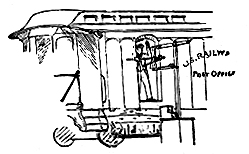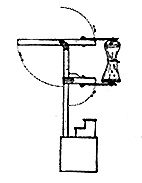When the stations at which pouches are caught are within a mile or two of each other, the greatest activity is needed to assort the mail between stations, to avoid carrying mail by destination and subjecting it to considerable delay before its delivery by a railway post-office on the train to be met at a point perhaps many miles ahead.
The manner of taking or “catching” the mail from the trackside by softie invisible power on a railroad train plunging through space has seemed to many a feat of almost legerdemanic skill, when all that is required is a simple mechanical apparatus and a quick, firm movement of the arm in using it at the right moment. A crane similar in appearance to the oldtime gibbet is erected near the track, and may have served as a warning by its suggestive appearance to some would-be train-wrecker. Its base is a platform two feet and a half square, with two short steps on top to assist the person hanging the pouch; a post ten feet in height passes up through this platform near the edge; a stout joist about five feet in length is fixed across the top of the post and so balanced that when relieved of the weight of the pouch it flies up perpendicularly against the post. The pouch used for this purpose is made of canvas and is -somewhat narrower than the ordinary leathern pouch. It is lightly suspended by a slender iron rod projecting from the horizontal joist, passed through a ring at the top and lightly held at the bottom in the same manner as at the top. When the pouch is snatched from the crane, the top piece flies up as described, and a parallel short joist at the bottom of the pouch drops.

“Catching” at Full Speed.
Pouch Hung on “Crane.”
|



